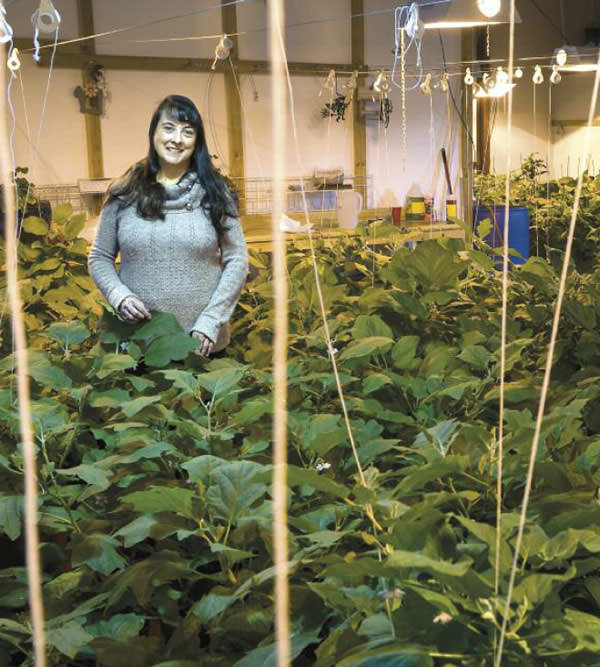meet the farmer
BRINGING TEFF TO THE TABLE
Local farmers find success with trending micro-grain.
WRITTEN BY HEIDI BETHEL
PHOTOS BY CANDICE NYANDO
An ancient staple in Ethiopian cuisine, the figurative glue that holds the injera (the unofficial flatbread of the nation) together, has turned into a cash crop for local farmers as it gains popularity in Northern Nevada and beyond.
Measuring 1/32 of an inch in diameter, teff is one of the smallest grains in the world. But don’t let that fool you; what it lacks in size, it makes up for in nutrition. This simple grain is similar to millet or quinoa and is higher in protein than wheat, while also containing additional nutrients, including fiber, iron, calcium, and thiamin. It’s also gluten free, making this earthy-flavored granule a perfect fit for those with celiac disease or wheat sensitivities.
Culinary Conundrum
In 2007, Jay Davison, area forage and alternative crops specialist for University of Nevada Cooperative Extension, was working alongside local farmers to solve a quandary affecting the industry for decades: water availability. He initially grew teff as an experiment and demonstration project from which he intended to use the results as a teaching tool for Nevada’s agricultural community.
“We wanted something we could plant on a drought year that we could do something with,” explains John Getto, co-owner of Desert Oasis Teff in Fallon. “We needed to be able to turn this crop around quickly with minimal use of water. Teff was it. It’s cheap to grow and is a very good producer.”
Getto and others in the farming community in Fallon began planting the crop, but as it matured and was ready to process, they ran into another problem.
“We didn’t know how to modify the harvesting equipment to reduce field loss and produce a quality product,” Davison says. “In addition, when the local growers decided to process it themselves, they had no idea how to clean it for the wholesale market.”
Initially, the crop was sent to California and Idaho to be processed, with a portion being ground into flour. This was an expensive venture that also reduced productivity. Members of the group were determined to find a solution.
“It took several months, a great number of equipment purchases, and a large amount of money to learn the process necessary to produce a saleable product,” Davison says.
Through continued consultations with equipment manufacturers, field trips to discuss the crop with other producers, and persistence through the trial-and-error process, teff is now grown, cleaned, and successfully milled in Northern Nevada.
“Now that we have our own equipment, this is the first year we’ve been cleaned out with no seed left in the middle of June,” Getto says. “It’s been flying off the shelves.”
Davison estimates that about half the teff sold as grain or flour in the U.S. is now grown in Nevada, with Nevada and Idaho constantly competing for top producer status. The gross value of teff grain being produced in the state now reaches $1 million annually.

Serving the Customer
Initially, Desert Oasis Teff primarily sold to Ethiopian restaurants in Nevada, such as Zagol in Reno, and surrounding states. As gluten-free products continue to advance, Getto and others are reaping the benefit of selling to an expanding market, including Bob’s Red Mill Natural Foods, whose products are sold at Whole Foods Market and other health food outlets.
“The product demand is increasing annually,” Davison explains. “The primary driver of this demand is individuals who are gluten intolerant or want to eat more of the so-called ancient grains. It is showing up in tortillas, chips, cookies, and all other products that are used to satisfy the demand for gluten-free flour.”
With simple hazelnut notes, teff, in its grain form, can be used as rice or in hot cereal, while the milled version works well in baking or as a thickener for soup, stew, and gravy. Davison adds that from a health standpoint, teff provides individuals with gluten intolerance an additional source of grain and flour, bringing an ideal alternative to any meal at the table.
Heidi Bethel is a local freelance writer who enjoys exploring new food trends and always is looking for a nutritious delight such as teff.
Teff Banana Bread
(courtesy of Bob’s Red Mill Natural Foods. Serves 12)
1 cup banana, mashed
½ cup date pieces or pitted dates (halved crosswise)
1 cup currants
½ cup hazelnuts, coarsely chopped
½ teaspoon salt
½ teaspoon baking soda
½ teaspoon baking powder
1 teaspoon cinnamon
1 cup Turbinado sugar
½ cup unsalted butter
1 egg, beaten
¼ teaspoon anise extract
1¾ cups teff flour
Preheat oven to 350 degrees F.
Toss a few tablespoons of teff flour over dates, currants, and hazelnuts and set aside. Blend baking soda, baking powder, salt and cinnamon with remaining flour.
Cream together butter and sugar. Mix in eggs, anise, and banana. Add to dry ingredients, stir in nuts and fruits, and mix well.
Spoon into a greased 9-inch loaf pan and bake for 40 to 45 minutes, or until toothpick inserted in the center comes out clean.
For more teff recipes, visit www.Bobsredmill.com.


